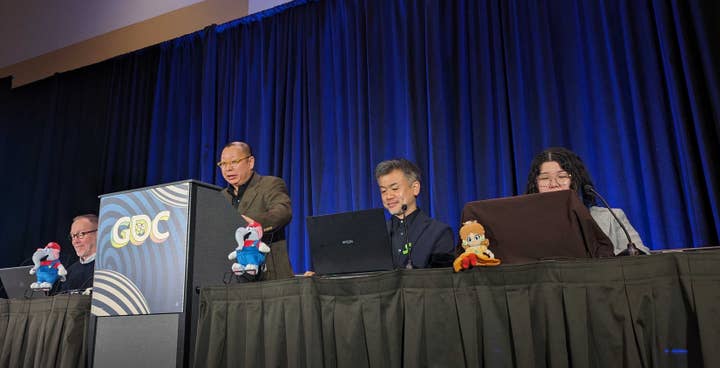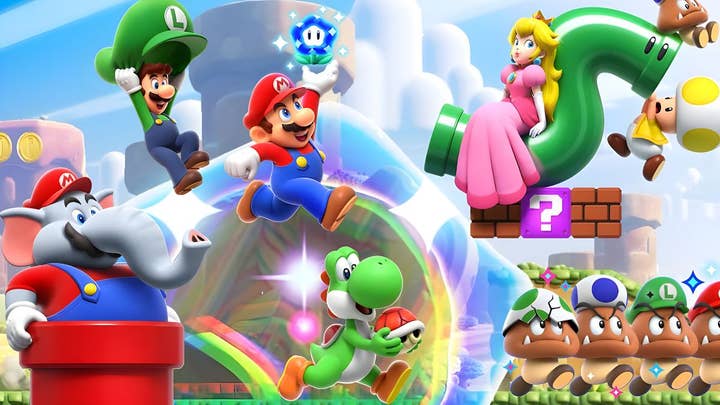Behind the scenes of Super Mario Bros Wonder | GDC 2024
Nintendo's Takashi Tezuka and Shiro Mouri recount the creation of the title's Wonder effects
During a GDC talk yesterday, Nintendo looked back at the creative process for Super Mario Bros Wonder, particularly how the large development team dealt with incorporating everyone's input when creating the game's 'Wonder effects'.
The first 2D Mario platformer in 11 years, Super Mario Bros Wonder released last October. It features the aforementioned Wonder effects, which change aspects of a level often in drastic ways, whether that's affecting the screen's orientation, Mario's abilities, or leads to Piranha plants breaking into song.
The talk featured Nintendo's Takashi Tezuka (producer of Super Mario Bros Wonder) and Shiro Mouri (the game's director), who shared the particular challenge of releasing a new 2D Mario game after so much time: how do you create a world revolving around secret abilities and overall mysteries when secrets and mysteries are already the franchise's standard?
"Nintendo believes that everyone on the team is a game designer"Shiro Mouri
This led to the creation of the Wonder effects, with Tezuka explaining the challenges faced when working with such a big team.
"As hardware has evolved, the size of development teams has increased in proportion to the scale of game production," he says. "And something we didn't focus on during the NES days, which was team management, is now an important job.
"Getting lots of people to work in the same direction to develop a game with as little waste as possible is without a doubt an important job. However, there's something even more important. Working with many people means we are also working with many abilities and approaches. So it's about how we can represent each person's individuality and strengths in production, and team management should be developed for this purpose."
The creation of the Wonder effects were a team effort, Mouri continued.
"Many types of Wonder effects are needed to fill a game with the secrets and mysteries. We [did] brainstorming sessions where the whole team showed their ideas for Wonder effects. It was up to everyone on the team to come up with ideas regardless of job title or seniority. Nintendo believes that everyone on the team is a game designer.
"At first, we asked everyone to write any and all ideas on sticky notes without any conditions. After all, if you start with conditions, you stifle creative freedom. At this stage, we collected around 2,000 ideas. As we looked at the various ideas that came up, we were able to gradually narrow down what criteria made up good Wonder effects."

One such criteria was to have a connection between what Nintendo called the 'pre-Wonder effect' (so the world around Mario before the effect is triggered) and the Wonder effect itself.
"For example, if the players were to suddenly transform into balloon Mario during a Wonder effect, that would feel unnatural," Mouri explained. "However, by having 'balloonesque' enemies appear first, then having the player transform into balloon Mario due to a Wonder effect, the feeling of unnaturalness is removed."
The Wonder effects' other criteria was that they could be explained simply in one short phrase, and having players suddenly be able to do something that they could not before.
"With these figured out, we started to try on different ideas that met these criteria," Mouri added. "This testing phase was also conducted by everyone on the team. Each testing [team] was comprised of one game designer, one artist, one programmer, and one sound engineer. When necessary, we created new temporary design data and sound data.
"Once the testing phase was over, all team members would play the prototype, then show their opinions. In response to these opinions, team members would share and layer even more ideas. And this eventually led to the product version taking shape. More than half the prototypes did not make it to the final product, but these testing sessions had many effects… Everyone gained development experience, everyone's motivation increased, and the team solidarity improved. And more importantly with this, coming up with prototypes is just fun!"
"If you start with conditions, you stifle creative freedom"Shiro Mouri
He then showed examples of Wonder effects that were adopted off the back of these testing sessions, including the ground tilting and the inclusion of a quiz in the middle of a level.
Tezuka and Mouri addressed the fact that players' taste has changed over the years, and with Wonder the team tried to address a challenge of past Mario games, namely the limited player choice. In Wonder, players are able to choose between different abilities, unlocking various paths or different ways to finish a level, and the development team also gave them more freedom the explore the maps and pick and choose which levels to do.
They both noted the initial uncertainty about how to tackle the various challenges that came with making the game, but ultimately said that creating something that nobody holds the answer to is exactly what made it fun, as they were able to uncover the answer together as a team.
Having gone in depth about the Wonder effects, also showing some discarded prototypes along the way (including one that would have seen Mario and the entire background turn into real life versions of themselves, paired with Mario humming the music and all the sound effects!) the pair concluded the talk by chatting about the future of 2D games.
"Super Mario Brothers turns 40 next year," Mouri started. "You might think it's difficult to make such a long-running series evolve. However, new play is created by facing and solving the challenges that come with 2D titles. This, of course, is not limited to Super Mario Brothers titles. By doing this, I believe 2D games will continue to evolve into the future. "

Tezuka continued: "We know that there are many ways to create games. But the first thing we think deeply about is what will become the core of the game. I get very worried about production if I can't imagine what's going to be the fun of the game before we start polishing the graphics, sounds, and on-screen presentation. If we proceed without that understanding, I don't think anything becomes more interesting as we move forward. This is why I think it's good to put a considerable amount of effort into finding the core of the game.
"In addition to thinking about the core of the game and gameplay, we also need to verify they work and, for various reasons, that's easy to do with 2D games. 2D games have a simple structure which makes it easier to focus on creating gameplay."
He added that he wasn't implying that the time and effort ultimately required to create a game is different between 2D and 3D, but emphasised that in the specific case of 2D Mario, it's easier to make adjustments to courses and add new elements throughout development.
"While we move forward taking on the challenges inherent in this franchise, a variety of new technologies will be created, blended with traditional 2D presentation, and perhaps gameplay itself will change.
"Mr. Mouri talked about how 2D games will continue to evolve. Perhaps I'm the one most looking forward to that future. Maybe somebody in this audience will create a new 2D game and of course, we hope to continue creating new ways to play in the years to come. Thinking about gameplay is super fun."
Sign up for the GI Daily here to get the biggest news straight to your inbox



